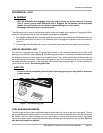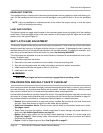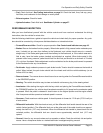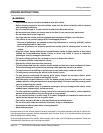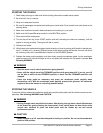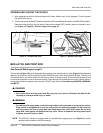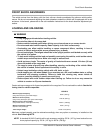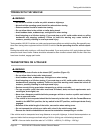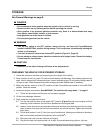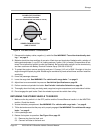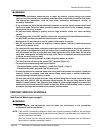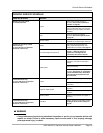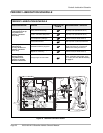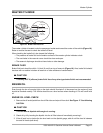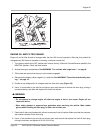
Storage
2005 HUV4213 Gasoline Vehicle Owner’s Manual Page 21
STORAGE
See General Warnings on page 8.
ý DANGER
• Do not attempt to drain gasoline when the engine is hot or while it is running.
• Be sure to clean up any spilled gasoline before operating the vehicle.
• Store gasoline in an approved gasoline container only. Store in a well-ventilated area away
from sparks, open flames, heaters, or heat sources.
• Keep gasoline out of the reach of children.
• Do not siphon gasoline from the vehicle.
ý WARNING
• Turn the key switch to the OFF position, remove the key, and leave the Forward/Reverse
handle in the NEUTRAL position during storage. This is to prevent unintentionally starting the
vehicle or a fire hazard.
• Turn the fuel shut-off valve to the closed (OFF) position (Figure 12, Page 22).
• Do not attempt to charge frozen batteries or batteries with bulged cases. Discard the battery.
Frozen batteries can explode.
ý CAUTION
• Batteries in a low state of charge will freeze at low temperatures.
PREPARING THE VEHICLE FOR EXTENDED STORAGE
1. Unload the vehicle so that tires are supporting only the weight of the vehicle.
2. Store vehicle in a cool, dry place. This will minimize battery self-discharge. If the battery appears to be
weak, have it charged by a trained technician. Use an automotive-type 12-volt battery charger rated at
10 amps or less. Check electrolyte level after charging and add distilled water if necessary.
3. Make sure the key switch is in the OFF position and the Forward/Reverse handle is in the NEUTRAL
position. Chock the wheels.
4. Access the engine compartment. See WARNING “For vehicles with cargo beds...” on page 8.
4.1. Tilt the bed and ensure that the prop rod is properly engaged.
5. Lift the front passenger side seat.
6. Drain carburetor and seal the fuel tank.
6.1. Turn the fuel shut-off valve to the closed (OFF) position (Figure 13) and run the engine until fuel
remaining in the carburetor and fuel line is depleted and the engine stalls.
6.2. Loosen, but do not remove, the carburetor drain screw and drain fuel remaining in bowl into a small,
clean container, then pour the fuel from the container into vehicle fuel tank. Tighten the carburetor
drain screw.
6.3. Fill fuel tank to about 1 inch (2.5 cm) from top of fuel tank and, following manufacturer’s directions,
add a commercially available fuel stabilizer (such as Sta-Bil
®
).
6.4. Disconnect fuel vent line from fuel tank vent nipple.
6.5. Plug the fuel tank vent nipple so that it is air tight. We recommend using a slip-on vinyl cap.



